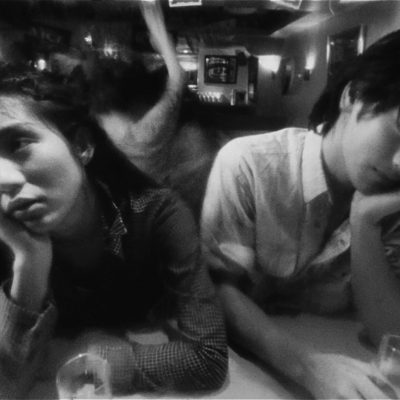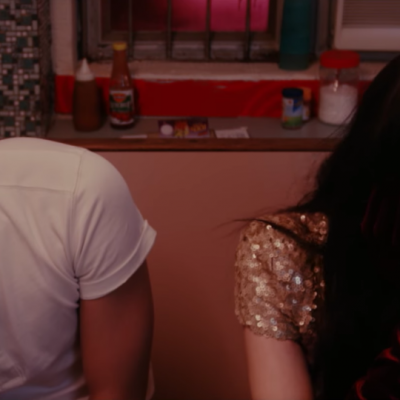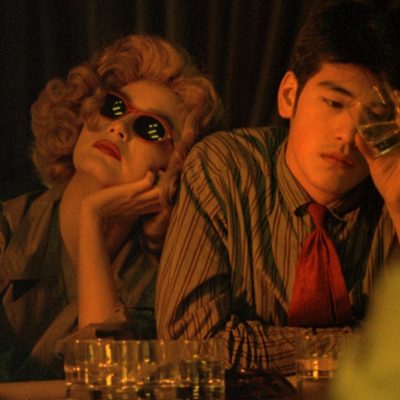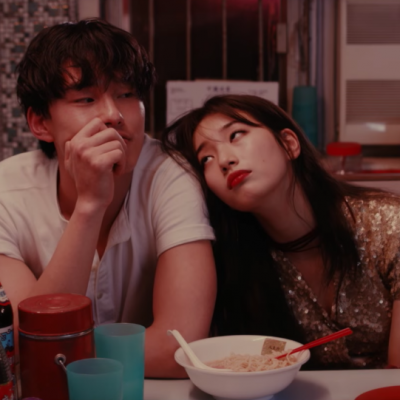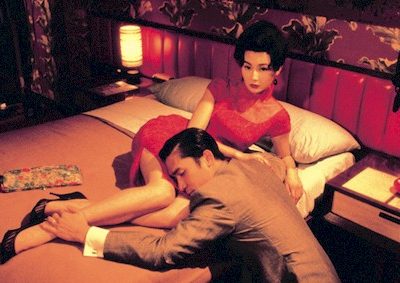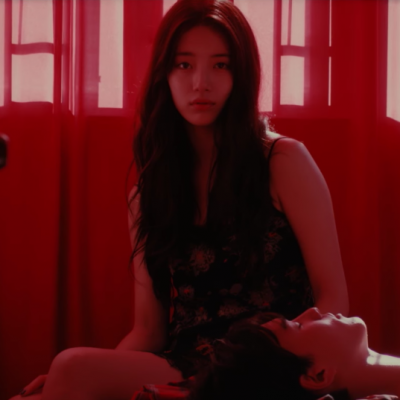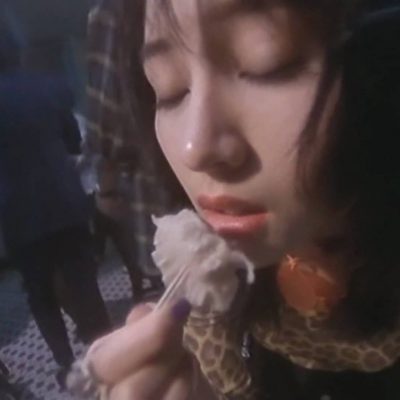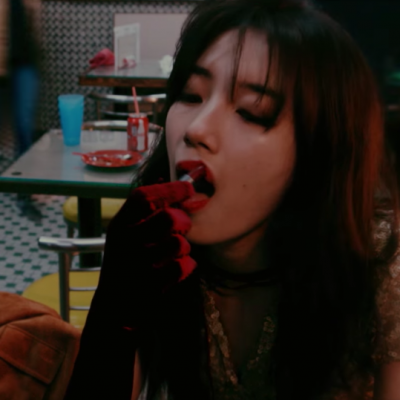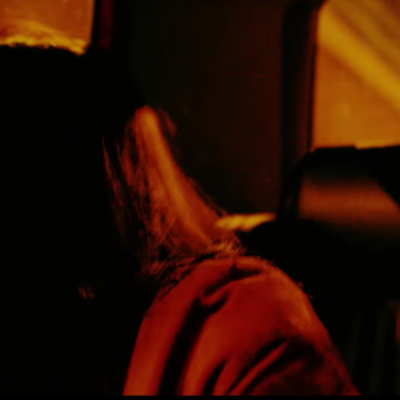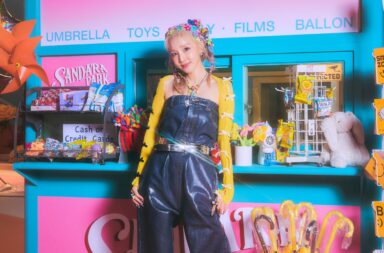The time has finally come for JYP to debut Suzy as a soloist. With the future of Miss A in question, Suzy’s popularity at an all time high, and the success of her duet with Exo‘s Baekhyun last year, it was definitely prime time to invest properly in Suzy’s musical future. The highly anticipated debut was all the more hyped up with the pre-release “Pretend,” that instantly dominated music charts. “Yes No Maybe” retains the raw vulnerability of “Pretend,” but unlike the understated softness of the latter, “Yes No Maybe” is a much more mature, and far more cinematic debut.
“Yes No Maybe” evokes Hong Kong cinema of the 1990’s — specifically the films of Wong Kar Wai. Perhaps the most influential director of Hong Hong’s second wave of cinema, Wong Kar Wai told the love stories of Hong Kong’s grimy underbelly with a signature style that is easily recognizable — even two decades later. “Yes No Maybe” isn’t shy about its influences either, mimicking shots directly from films like Chungking Express and Fallen Angels to tell Suzy’s own ill-fated love story.
In a reminiscent and pointedly stylized way, “Yes No Maybe” opens with credits of Suzy’s name and the album title in bold Chinese characters against a vibrant red backdrop. It’s clear from the onset that Suzy is the star of this mini film, and all eyes will be on her. Like many a Wang Kar Wai protagonist, we see Suzy in”Yes No Maybe,” as a woman caught up in a love affair she can’t seem to escape from.
Intentionally grainy film textures are used to blur the line of vision and heighten the tension as Suzy stumbles around the streets on Hong Kong in the opening shots. The story truly begins with Suzy awaking alone in bed, already thinking of calling her lover, but fighting with herself not to.
Don’t pick up
I know when I hear your voice
My heart will shake again
Though I tried to just talk to you
She finds herself meeting up with him in the diner — another Wong Kar Wai staple — where she gazes at him from across the table in apparent boredom with a hint of anxiety. Tension continues to build within the small set, where everything is compressed through time lapse — as if all the air is gone from the room as Suzy and the man are suspended in time with the world moving on around them. She doesn’t want to be with him, but she doesn’t want to be without him, and she can’t seem to keep herself away.
Another day dawns, and Suzy is alone in the laundromat. Once again, Suzy hangs in the interim of boredom and longing, almost waiting for her lover to come tug her out of her doldrums — which he does. Here, we see the rush her lover brings her in the dark aisles of a jewelry store, where she takes what she wants and walks away. It’s clear that she’s fallen into a dangerous cycle, and all her inner turmoil is contrasted with the apathy on her face.
Yes no maybe
I don’t know my heart
I try to not see you ever again
But I’m going to you again
Now no more baby
I hate myself for doing this, hate me
I can’t not see you
But I can’t see you either
The dark, apathetic thrill of the heist is contrasted with the intimacy of her bedroom where she and her lover play between the sheets in a sea of red. Even in the daylight of her bedroom, the only natural light that reaches the characters is filtered through the red curtains — blurring the set together, with only their bodies being fully fleshed out against the furniture.
In a particularly poignant bedroom shot, Suzy covers her lover’s eyes to temporarily remove herself from his vision in a way that her heart won’t allow her to do. Gazes play a big role in this MV, with the male gaze and the camera being set on Suzy for most of the frames. But what makes the use of the gaze so interesting is that Suzy stares right back. She’s fully aware she’s being watched, and looks directly into the camera — into the eyes of her lover — with nothing but apathy. It isn’t until Suzy turns her gaze on herself in the final moments of the MV that we see the first hint of vulnerability beneath the facade of emptiness. It’s as if she’s saying, ‘I don’t care how you see me, but I don’t like how I see myself when I’m with you.’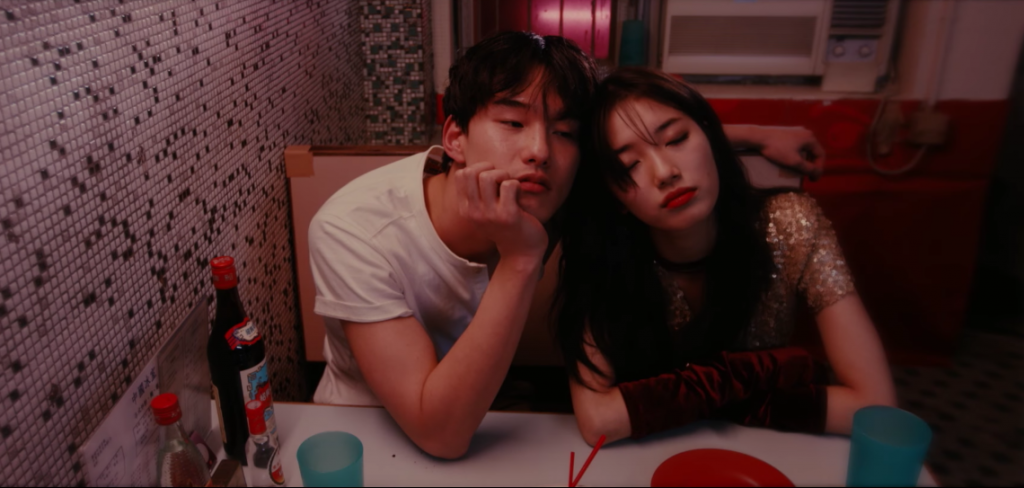
In addition to the use of the gaze, “Yes No Maybe” is also notable for its use of color. In true Wong Kar Wai fashion, each set has its own saturated color scheme that works to keep the tones of the narrative shifting throughout the MV. Red is the dominant color and draws out the lust, intimacy, and even guilt Suzy feels as she gazes at her lover under the sheets; the blues show her boredom when he is away; the oranges play in a strange middle ground of indecision as Suzy attempts to walk away from her lover once again. The colors are also cyclical, like the shift between day and night, building a routine of boredom, anxiety, apathy, and longing.
The contrast of exposures between the night and day scenes is employed quite well to show Suzy’s conflicting emotions. The natural light of the day is contrasted with the artificial light of the diner, and the darkness of the Hong Kong streets; these night-time shots are also handled with a lower exposure, higher contrast, keeping the blurred dark aesthetic that the MV wants to convey. As the narrative progresses, the MV continues to darken the exposure, bringing less and less clarity as Suzy slowly becomes more disillusioned with her situation. Both the scenes and narrative come to their darkest when she stumbles through the Hong Kong roads in a daze after possibly killing her lover.
The mini film ends on a cryptic note, with two seemingly dead bodies in a bathroom and Suzy fleeing the scene in silence. With the dawning of a new day, the color scheme returns to red, and the final shots are of Suzy alone in bed, with an overlay of a traditional Buddhist saying:
The flag does not move, the wind is not blowing, it is just your heart that is beating.
There’s a lot that left to mull over when the MV draws to a close, and — perhaps intentionally — multiple viewings won’t grant much more plot clarity. The stylized, almost hypnotic, vagueness of the MV is appealing, but I do wish it offered just bit more to work with. There are so many pieces to the tale, and there’s so much left out. Even the murder of her lover is not a definite thing, especially with two lifeless bodies being shown in the bathroom. Maybe he cheated, or maybe the second body is meant to represent Suzy leaving the love behind.
The quote at the end provokes the idea that maybe the love wasn’t as dangerous as Suzy thought it to be; that maybe she misinterpreted the stirrings of her own heart and couldn’t accept her own attachment. Either way, the love story draws to a close with Suzy right back where she started, alone in bed in the mid-morning — hinting that the cycle is about to begin again.
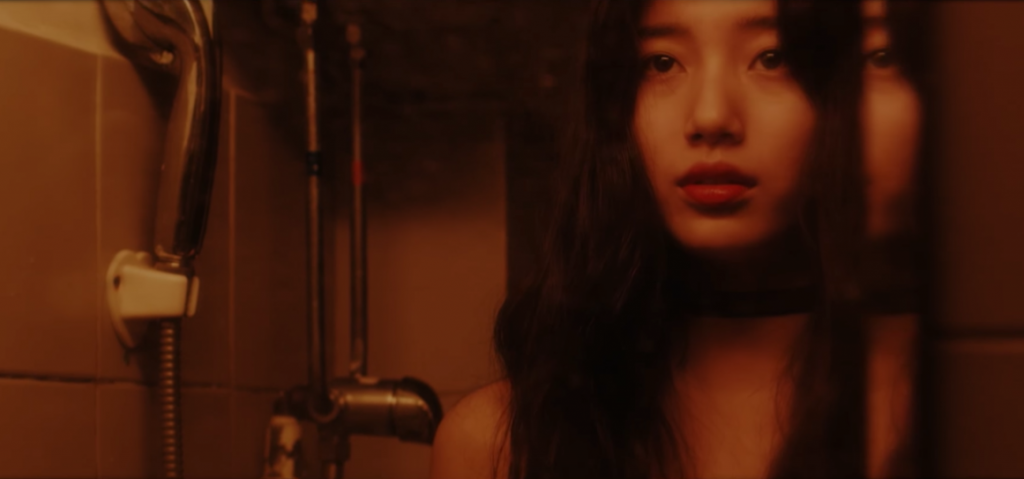
The cyclic nature of the MV is reflected in the track itself, both lyrically and musically. Listening to “Yes No Maybe” is like listening to spiral — the low deliberation of the first verse contrasted with the powerful indecision of the chorus, only to fall right back into the lower register again in the second verse. The lyrics are repetitive, the beats hypnotic and minimal, and the song ends right where it began — with a refrain of the first verse instead of a final chorus.
“Yes No Maybe” is very much a Park Jin-young track. Co-produced with Kairos, “Yes No Maybe” plays to JYP’s signature open sound, with minimal but steady instrumentation that sets the vocals front and center. The MV succeeds in conveying sexual tension, but something about the vocal dynamics of the track fail to do the same. It’s clear where the tension was meant to fall, but something about Suzy’s delivery, and the mixing of the vocals, doesn’t set quite right to make the tension of the lyrics felt. In a way, it feels like Suzy was told the dynamics of “Yes No Maybe” and how she should sound to convey tension, and simply followed the script rather than feeling the actual song itself.
With the vocals being set so far in front of the instrumentals, the sudden shift of vocal dynamics from the verses to the chorus is jarring, and a little uncomfortable at first listen. “Yes No Maybe” really could have benefitted from more from some sort of vocal middle ground. Harmonies also could have added depth to the vocals that feel a bit one dimensional with such minimal vocal layering. The breathy hook of “Da-da-da yes? No no. Yes, no” and the bridge both attempt to add balance, but fall slightly short. It’s still a fine listen, and definitely has some repeat value, but every time I listen I can’t help but feel that something is just slightly off with the production.
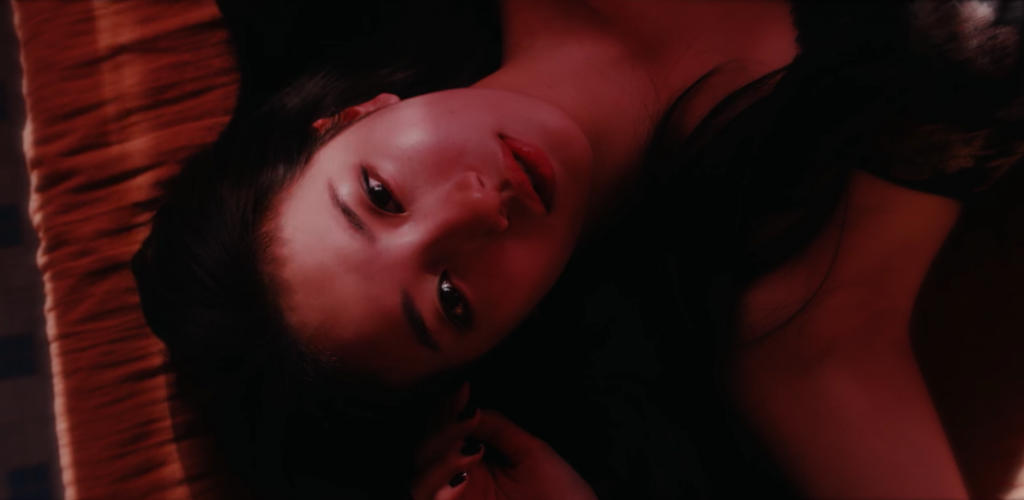
Overall, this debut is more of a success in concept than a musical triumph — and that’s okay. There’s no dancing and minimal lip-syncing to keep the MV as cinematic as possible, which I really like. More than anything, the stylistic influences of Wong Kar Wai work really well for this concept. Wong Kar Wai films are known for their portrayal of longing in a world of vices, and that theme is exactly what the lyrics of “Yes No Maybe” center around.
It’s apparent that JYP spared no expense for this debut, and went all out to craft a cohesive and marketable concept for Suzy as a trendy femme fatale of sort. “Yes No Maybe” is intentionally unpolished, intentionally vague, and intentionally aesthetic — and that’s really not a bad thing because it’s done so well. The style of Wang Kar Wai is emulated and re-configured in a way that is visually interesting, nostalgic and cohesive. “Yes No Maybe” is by no means the next Chungking Express or Fallen Angels, but it is a lovely homage that captures the visuality of a director and film movement I very much enjoy.
MV: 4/5
(YouTube. Images via JYP Entertainment, Jet Tone Productions. Lyrics via Pop!Gasa.)
